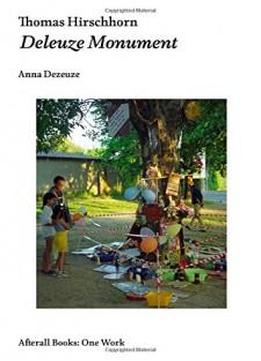
Thomas Hirschhorn: Deleuze Monument (afterall)
by Anna Dezeuze /
2014 / English / PDF
2.5 MB Download
Part-text, part-sculpture, part-architecture, part-junk heap,
Thomas Hirschhorn's often monumental but precarious works offer a
commentary on the spectacle of late-capitalist consumerism and
the global proliferation of commodities. Made from ephemeral
materials -- cardboard, foil, plastic bags, and packing tape --
that the artist describes as "universal, economic, inclusive, and
[without] any plus-value," these works also engage issues of
justice, power, and moral responsibility. Hirschhorn (born in
Switzerland in 1957) often chooses to place his work in non-art
settings, saying that he wants it to "fight for its own
existence." In this book, Anna Dezeuze offers a generously
illustrated examination of Hirschhorn's
Part-text, part-sculpture, part-architecture, part-junk heap,
Thomas Hirschhorn's often monumental but precarious works offer a
commentary on the spectacle of late-capitalist consumerism and
the global proliferation of commodities. Made from ephemeral
materials -- cardboard, foil, plastic bags, and packing tape --
that the artist describes as "universal, economic, inclusive, and
[without] any plus-value," these works also engage issues of
justice, power, and moral responsibility. Hirschhorn (born in
Switzerland in 1957) often chooses to place his work in non-art
settings, saying that he wants it to "fight for its own
existence." In this book, Anna Dezeuze offers a generously
illustrated examination of Hirschhorn'sDeleuze Monument
Deleuze Monument
(2000), the second in his series of four
(2000), the second in his series of fourMonuments
Monuments.
.Deleuze Monument
Deleuze Monument -- a sculpture, an altar, and a library
dedicated to Gilles Deleuze -- was conceived as a work open to
visitors twenty-four hours a day, seven days a week. Part of the
exhibition "La Beauté" in Avignon, Deleuze Monument was
controversial from the start, and it was dismantled two months
before the end of the exhibition after being vandalized. Dezeuze
describes the chronology of the project, including negotiations
with local residents; the dynamic between affirmation and
vulnerability in Hirschhorn's work; failure and "scatter art" in
the 1990s; participatory practices; and problems of presence,
maintenance, and appearance, raised by Hirschhorn's
acknowledgement of "error" in his discontinuous presence on site
following the installation of
-- a sculpture, an altar, and a library
dedicated to Gilles Deleuze -- was conceived as a work open to
visitors twenty-four hours a day, seven days a week. Part of the
exhibition "La Beauté" in Avignon, Deleuze Monument was
controversial from the start, and it was dismantled two months
before the end of the exhibition after being vandalized. Dezeuze
describes the chronology of the project, including negotiations
with local residents; the dynamic between affirmation and
vulnerability in Hirschhorn's work; failure and "scatter art" in
the 1990s; participatory practices; and problems of presence,
maintenance, and appearance, raised by Hirschhorn's
acknowledgement of "error" in his discontinuous presence on site
following the installation ofDeleuze Monument
Deleuze Monument.
.











